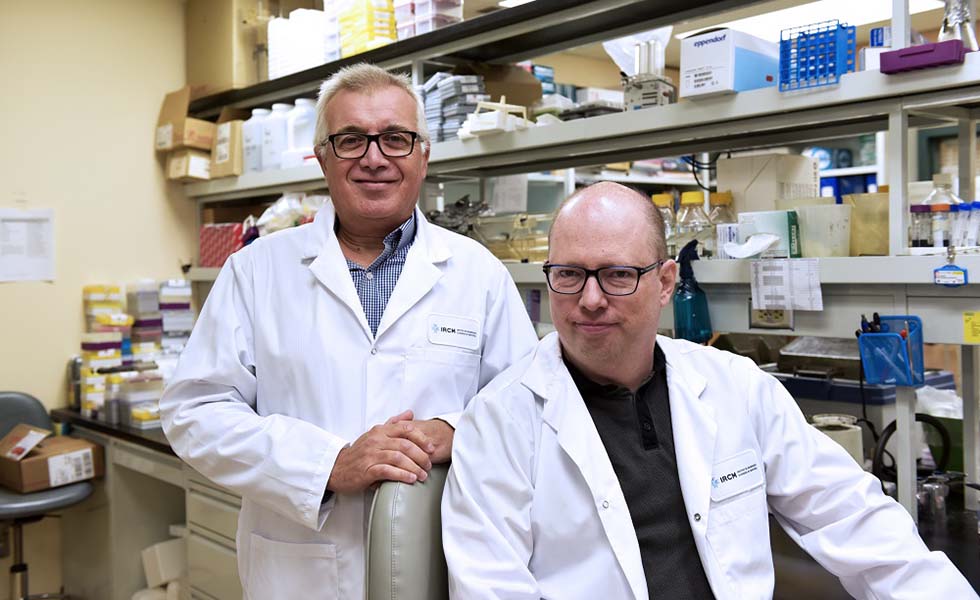
Now that medication can keep HIV under control and prevent progression to AIDS, researchers around the world are moving to the next step: eradicating the virus or, at least, controlling it without having people living with HIV to take anti-retroviral drugs for the rest of their lives. Indeed, HIV is cunning as it lies dormant in certain immune cells, in particular, lymphocytes and macrophages. These viral niches or reservoirs allow HIV to escape medication and reactivate the infection when therapy is stopped. But how does HIV create these reservoirs? And how can we eliminate or control them?
This is what scientists are trying to find out so that HIV/AIDS can be cured. Éric Cohen, Director of the Human Retrovirology Research Unit at the Montreal Clinical Research Institute (IRCM), and members of two pan-Canadian research teams—the Canadian NeuroAIDS Research Team (CNART) and the Canadian HIV Cure Enterprise (CanCURE)—have found part of the answer. They have identified a defense mechanism that allows macrophages to protect themselves from infection. This breakthrough raises the possibility of preventing the establishment of reservoirs in macrophages, especially in the central nervous system where such cells play a major role in HIV persistence.
The researchers suspected that macrophages were reservoirs because the virus infects them without destroying them, and they exhibit inflammatory responses even when the infection is controlled by medication. In addition, “as macrophages show varying degrees of susceptibility to infection, we thought that their defense mechanisms must vary depending on their tissues of origin,” explains Dr. Cohen, who leads CanCURE. By analyzing macrophages in more detail, the research group noticed that some cells, such as those in the intestines, resist viral infection. How do they do it? Éric Cohen and Robert Lodge, lead author of the study and an IRCM research associate, suggest that susceptibility to infection is partly controlled by microRNAs: very small non-coding molecules that “filter” instructions carried by messenger RNAs. In this way, microRNAs control protein expression in cells.
To check their hypothesis, the scientists analyzed the profile of microRNAs in blood samples donated by healthy volunteers. First, they isolated the monocytes, the precursors of macrophages. In the laboratory, they differentiated them into macrophages, which they exposed to HIV. The outcome: only 5% to 10% of the cells were infected by the virus, and the rest resisted infection. The researchers then identified over 400 different microRNAs that were modulated among the infected and non-infected cells. Two of the microRNAs, 221 and 222, specifically prevent macrophages from synthesizing the protein CD4, the receptor by which HIV enters and infects a cell. In other words, these two microRNAs close the door to the virus.
But why do only some macrophages have these protective microRNAs? “It seems that these microRNAs are part of the antiviral response of macrophages in some tissues,” says Dr. Cohen, who will be addressing this question in a subsequent study. Now that researchers understand how some macrophages fight HIV infection, they hope to be able to increase the production of microRNAs 221 and 222 to make all macrophages HIV-resistant. With one less place to hide, HIV will find it more difficult to outsmart medication and persist in the body.
About the study
The study was conducted by Robert Lodge, Jérémy A. Ferriera Barbosa, Félix Lombard-Vadnais, Julian C. Gilmore and Mariana G. Bego of the IRCM Human Retrovirology Research Unit under the direction of Éric Cohen in close collaboration with Alexandre Deshiere and Michel J. Tremblay of the Infectious and Immune Diseases Research Division of the CHU de Québec-Université Laval Research Centre, Annie Gosselin, Tomas Raul Wiche Salinas and Petronela Ancuta of the Centre de Recherche du CHUM, Christopher Power of the University of Alberta and Jean-Pierre Routy of the McGill University Health Centre Research Institute.
The study was funded by the Canadian NeuroAIDS Research Team, the Canadian HIV Cure Enterprise (CanCURE) of the Canadian Institutes of Health Research, the Canada Research Chairs Program and the IRCM-Université de Montréal Chair of Excellence in HIV Research. The study also relied on infrastructure and patient cohorts of the AIDS and Infectious Disease Network, which is supported by the Fonds de recherche du Québec — Santé.
About the IRCM
Founded in 1967, the Montreal Clinical Research Institute (IRCM) is a non-profit organization that conducts fundamental and clinical biomedical research in addition to training high-level young scientists in an innovative technological environment. Bringing together among 425 people, the institute brings together 34 laboratories, which work in cancer, immunology, neuroscience, cardiovascular and metabolic diseases, systems biology and medicinal chemistry. The IRCM also operates a research clinic specialized in hypertension, cholesterol and diabetes as well as a research centre on rare and genetic diseases in adults. The IRCM is affiliated with the Université de Montréal and associated with McGill University. Its clinic is affiliated with the Centre hospitalier de l’Université de Montréal (CHUM). The IRCM is supported by the Ministère de l’Économie, de la Science et de l’Innovation (Quebec ministry of Economy, Science and Innovation). The Institute is proudly celebrating its 50th anniversary in 2017.
Source:
Anne-Marie Beauregard, Communication Advisor, IRCM
514 987-5555 | anne-marie.beauregard@ircm.qc.ca




